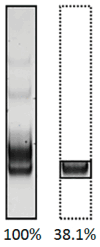Specific Aspects of SELEX Protocol: Different Approaches for ssDNA Generation
- PMID: 40278510
- PMCID: PMC12029403
- DOI: 10.3390/mps8020036
Specific Aspects of SELEX Protocol: Different Approaches for ssDNA Generation
Abstract
Background: Synthetic DNA aptamers are a class of molecules with potential applications in medicine, serving as molecular sensors or ligands for targeted drug delivery. Systematic evolution of ligands by exponential enrichment (SELEX) is a technology for selecting functional aptamers that was first reported three decades ago and has been actively developed since. SELEX involves multiple iterations of two fundamental steps: (i) target affinity-based partitioning of aptamers from a random library and (ii) amplification of selected aptamers by PCR, followed by isolation of single-stranded DNA (ssDNA). SELEX protocols have diversified considerably, with numerous variations possible for each step. This heterogeneity makes it challenging to identify optimal methods. Comparative analysis of different approaches for the major stages of SELEX is therefore of considerable practical importance.
Methods: Four widely used methods for ssDNA generation were performed in parallel: (a) PCR followed by digestion of the antisense strand with exonuclease lambda, (b) PCR with an extended primer followed by size-dependent strand separation using denaturing PAGE, (c) asymmetric PCR, and (d) asymmetric PCR with a primer-blocker.
Results: The specificity, efficiency, reproducibility, and duration of each method were compared.
Conclusions: Asymmetric PCR with a primer-blocker yielded the most favorable results.
Keywords: PCR; SELEX; aptamer; asymmetric PCR; single-stranded DNA.
Conflict of interest statement
The authors declare no conflicts of interest.
Figures







References
Grants and funding
LinkOut - more resources
Full Text Sources

